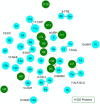Functional classification of protein structures by local structure matching in graph representation
- PMID: 29604149
- PMCID: PMC5980557
- DOI: 10.1002/pro.3416
Functional classification of protein structures by local structure matching in graph representation
Abstract
As a result of high-throughput protein structure initiatives, over 14,400 protein structures have been solved by Structural Genomics (SG) centers and participating research groups. While the totality of SG data represents a tremendous contribution to genomics and structural biology, reliable functional information for these proteins is generally lacking. Better functional predictions for SG proteins will add substantial value to the structural information already obtained. Our method described herein, Graph Representation of Active Sites for Prediction of Function (GRASP-Func), predicts quickly and accurately the biochemical function of proteins by representing residues at the predicted local active site as graphs rather than in Cartesian coordinates. We compare the GRASP-Func method to our previously reported method, Structurally Aligned Local Sites of Activity (SALSA), using the Ribulose Phosphate Binding Barrel (RPBB), 6-Hairpin Glycosidase (6-HG), and Concanavalin A-like Lectins/Glucanase (CAL/G) superfamilies as test cases. In each of the superfamilies, SALSA and the much faster method GRASP-Func yield similar correct classification of previously characterized proteins, providing a validated benchmark for the new method. In addition, we analyzed SG proteins using our SALSA and GRASP-Func methods to predict function. Forty-one SG proteins in the RPBB superfamily, nine SG proteins in the 6-HG superfamily, and one SG protein in the CAL/G superfamily were successfully classified into one of the functional families in their respective superfamily by both methods. This improved, faster, validated computational method can yield more reliable predictions of function that can be used for a wide variety of applications by the community.
Keywords: 6-Hairpin Glycosidase (6-HG) superfamily; Concanavalin A-like Lectins/Glucanase (CAL/G) superfamily; Graph Representation of Active Sites for Prediction of Function (GRASP-Func); Ribulose Phosphate Binding Barrel (RPBB) superfamily; Structurally Aligned Local Sites of Activity (SALSA); protein function annotation.
© 2018 The Authors Protein Science published by Wiley Periodicals, Inc. on behalf of The Protein Society.
Figures



References
-
- Gherardini PF, Helmer‐Citterich M (2008) Structure‐based function prediction: approaches and applications. Brief Funct Genomic Proteomic 7:291–302. - PubMed
-
- Kihara D, Ed. (2011) Protein function prediction for omics era, 1st ed Dordrecht: Springer.
-
- Sleator RD, Walsh P (2010) An overview of in silico protein function prediction. Arch Microbiol 192:151–155. - PubMed
-
- Lee D, Redfern O, Orengo C (2007) Predicting protein function from sequence and structure. Nat Rev Mol Cell Biol 8:995–1005. - PubMed
Publication types
MeSH terms
Substances
Associated data
- Actions
- Actions
- Actions
- Actions
- Actions
- Actions
- Actions
- Actions
- Actions
- Actions
- Actions
- Actions
- Actions
- Actions
- Actions
- Actions
- Actions
- Actions
- Actions
- Actions
- Actions
- Actions
- Actions
- Actions
- Actions
- Actions
- Actions
- Actions
- Actions
- Actions
- Actions
- Actions
- Actions
- Actions
- Actions
- Actions
- Actions
- Actions
- Actions
- Actions
- Actions
- Actions
- Actions
- Actions
- Actions
- Actions
- Actions
- Actions
- Actions
- Actions
- Actions
- Actions
- Actions
- Actions
- Actions
- Actions
- Actions
- Actions
- Actions
- Actions
- Actions
- Actions
- Actions
- Actions
- Actions
- Actions
- Actions
- Actions
- Actions
- Actions
- Actions
- Actions
- Actions
- Actions
- Actions
- Actions
- Actions
- Actions
- Actions
- Actions
- Actions
- Actions
- Actions
- Actions
- Actions
- Actions
- Actions
- Actions
- Actions
- Actions
- Actions
- Actions
- Actions
- Actions
- Actions
- Actions
- Actions
- Actions
- Actions
LinkOut - more resources
Full Text Sources
Other Literature Sources
Research Materials

